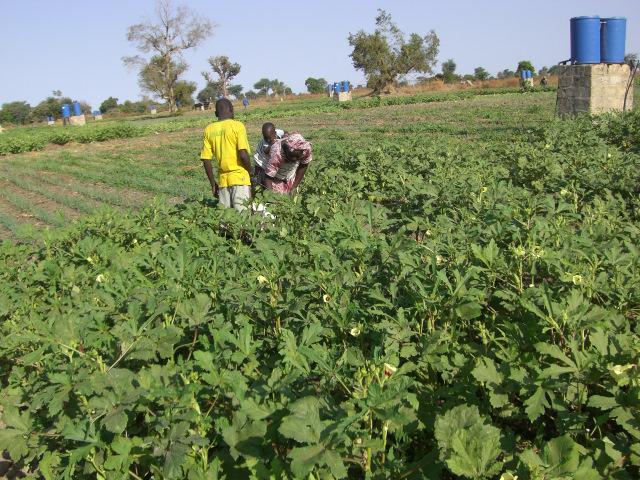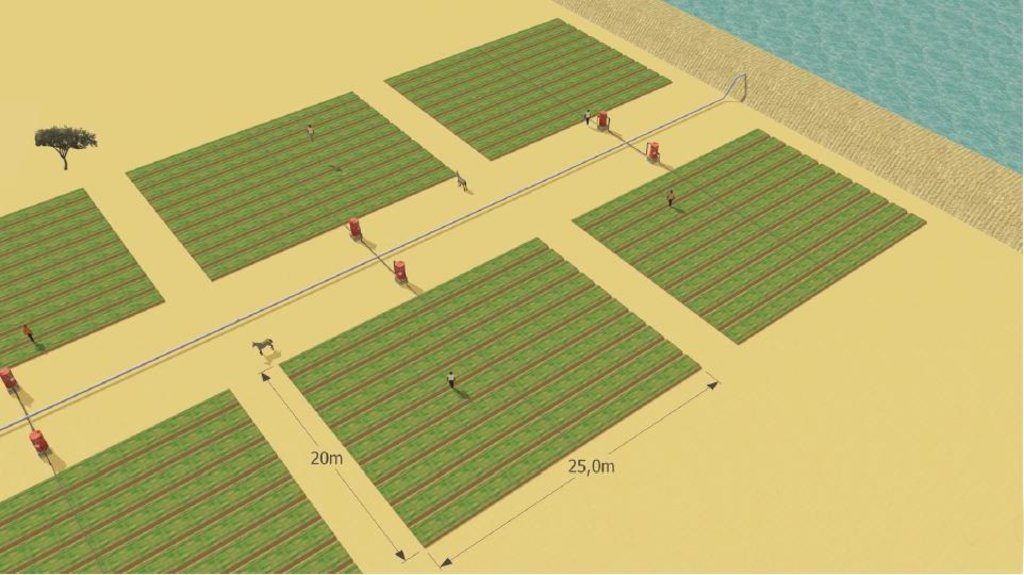African market gardens [Senegal]
- Creation:
- Update:
- Compiler: Julie Zähringer
- Editor: –
- Reviewer: Alexandra Gavilano
technologies_944 - Senegal
View sections
Expand all Collapse all1. General information
1.3 Conditions regarding the use of data documented through WOCAT
When were the data compiled (in the field)?
27/09/2009
The compiler and key resource person(s) accept the conditions regarding the use of data documented through WOCAT:
Yes
2. Description of the SLM Technology
2.1 Short description of the Technology
Definition of the Technology:
The African Market Garden (AMG) is a horticultural production system based on low-pressure drip irrigation.
2.2 Detailed description of the Technology
Description:
According to the level of experience, market orientation or social structure of the land users, four different AMG models have been developed. This case study focuses on the “Cluster System” which is suitable for an organized group of independent vegetable producers sharing a common water delivery system. From a central source, water is distributed through a pipe network to a cluster of plots. Each farmer operates a 1,000 m2 unit, and each is equipped with an elevated 200 litre barrel and a standard irrigation kit, including a tap, filter and thick-tube drip laterals. Minimal size of an AMG unit should be 500 m2. Affordable high-quality material is used and the design and operation is simple. The barrel also serves as a fertilizer tank. A float ensures a constant pressure head. Water supply is calculated by the time needed for delivery of the daily water dosage, or through the use of water dosing valves. Producers have individual control of water use. Since the AMG requires only 1 meter pressure for operation, it can draw on low-capacity renewable energy sources such as elevated dams, solar pumps or reservoirs. To supply an area of 50,000 m2 with 8 mm/day in the hot season a 400 m3-reservoir is required. The crops are planted on elevated beds. Water mixed with urea as fertilizer is applied daily. Drip irrigation improves growing conditions for crops while at the same time saving labor, water and other inputs. AMG is promoted as a holistic management package, integrating all aspects of production, post-harvest and marketing in one system. This includes the use of improved vegetable varieties, improved crop husbandry, integrated pest management, as well as improved storage, processing and marketing of products, and improved access to inputs.
Establishment / maintenance activities and inputs: The following establishment activities are connected to this technology: 1. Build concrete reservoir. 2. Drill borehole (110 mm diameter; 12 m deep, hand drilled). 3. Install motor pump and tubes to connect well with reservoir. 4. Install drip kit with tap, filter and drip laterals (8-16 mm in diameter). 5. Establish a fence to protect the garden.
For maintenance the following activities are required: 1. Prepare elevated beds with a basic dressing of 4 kg/m2 manure and 0.1 kg/m2 NPK fertilizer biannually. 2. Add urea to irrigation water (concentration: 50-100 ppm N). 3. Operate water supply system.
Natural / human environment: AMG is spreading fast in Senegal and Burkina Faso. Up-scaling of AMG in dry West Africa will depend on access to technology, inputs, knowledge and organization, and a conducive institutional environment.
2.3 Photos of the Technology
2.5 Country/ region/ locations where the Technology has been applied and which are covered by this assessment
Country:
Senegal
Further specification of location:
Ngoyé Ndioffogor and Mbassis Tadadem
Map
×2.6 Date of implementation
If precise year is not known, indicate approximate date:
- less than 10 years ago (recently)
2.7 Introduction of the Technology
Specify how the Technology was introduced:
- during experiments/ research
3. Classification of the SLM Technology
3.2 Current land use type(s) where the Technology is applied

Cropland
- Annual cropping
Comments:
Type of cropping system and major crops comments: AMG is suitable for urban/peri¬urban areas where producers have access to credit, markets, technical support
Strong organisation in groups is important for the maintenance of the system and for access to training/backstopping
3.3 Further information about land use
Water supply for the land on which the Technology is applied:
- rainfed
3.6 SLM measures comprising the Technology

management measures
- M2: Change of management/ intensity level

agronomic measures
- A6: Others
Comments:
Main measures: agronomic measures, management measures
3.7 Main types of land degradation addressed by the Technology

water degradation
- Hg: change in groundwater/aquifer level
- Ha: aridification
Comments:
Main type of degradation addressed: Ha: aridification, Hg: change in groundwater / aquifer level
3.8 Prevention, reduction, or restoration of land degradation
Specify the goal of the Technology with regard to land degradation:
- prevent land degradation
Comments:
Main goals: prevention of land degradation
4. Technical specifications, implementation activities, inputs, and costs
4.1 Technical drawing of the Technology
4.2 Technical specifications/ explanations of technical drawing
Cluster system with several AMG plots connected to a central water source - in this case a small elevated dam
Technical knowledge required for field staff / advisors: high
Technical knowledge required for land users: high
Main technical functions: increase of groundwater level / recharge of groundwater, water spreading
Agronomic measure: drip irrigation
4.3 General information regarding the calculation of inputs and costs
Indicate average wage cost of hired labour per day:
2.00
4.6 Maintenance/ recurrent activities
| Activity | Type of measure | Timing/ frequency | |
|---|---|---|---|
| 1. | Prepare elevated beds with a basic dressing of 4 kg/m2 manure and 0.1 kg/m2 NPK fertilizer biannually | Agronomic | biannually |
| 2. | Add urea to irrigation water (concentration: 50-100 ppm N) | Agronomic | |
| 3. | Operate water supply system | Agronomic |
4.7 Costs and inputs needed for maintenance/ recurrent activities (per year)
Comments:
A unit corresponds to the area irrigated by one producer (=500 m2). Establishment costs include labour inputs (2 US$ per person-day). Annual maintenance costs include labour, fuel and agricultural inputs (e.g. fertilizer, seeds; based on ICRISAT recommended rates). For a 1000m2-unit prices are doubled (except for tools and fence)
5. Natural and human environment
5.1 Climate
Annual rainfall
- < 250 mm
- 251-500 mm
- 501-750 mm
- 751-1,000 mm
- 1,001-1,500 mm
- 1,501-2,000 mm
- 2,001-3,000 mm
- 3,001-4,000 mm
- > 4,000 mm
Agro-climatic zone
- semi-arid
Thermal climate class: tropics
5.2 Topography
Slopes on average:
- flat (0-2%)
- gentle (3-5%)
- moderate (6-10%)
- rolling (11-15%)
- hilly (16-30%)
- steep (31-60%)
- very steep (>60%)
Landforms:
- plateau/plains
- ridges
- mountain slopes
- hill slopes
- footslopes
- valley floors
Altitudinal zone:
- 0-100 m a.s.l.
- 101-500 m a.s.l.
- 501-1,000 m a.s.l.
- 1,001-1,500 m a.s.l.
- 1,501-2,000 m a.s.l.
- 2,001-2,500 m a.s.l.
- 2,501-3,000 m a.s.l.
- 3,001-4,000 m a.s.l.
- > 4,000 m a.s.l.
5.3 Soils
Soil depth on average:
- very shallow (0-20 cm)
- shallow (21-50 cm)
- moderately deep (51-80 cm)
- deep (81-120 cm)
- very deep (> 120 cm)
Soil texture (topsoil):
- coarse/ light (sandy)
Topsoil organic matter:
- low (<1%)
5.6 Characteristics of land users applying the Technology
Market orientation of production system:
- commercial/ market
Individuals or groups:
- groups/ community
Level of mechanization:
- manual work
- mechanized/ motorized
Indicate other relevant characteristics of the land users:
Land users applying the Technology are mainly common / average land users
5.7 Average area of land owned or leased by land users applying the Technology
- < 0.5 ha
- 0.5-1 ha
- 1-2 ha
- 2-5 ha
- 5-15 ha
- 15-50 ha
- 50-100 ha
- 100-500 ha
- 500-1,000 ha
- 1,000-10,000 ha
- > 10,000 ha
Is this considered small-, medium- or large-scale (referring to local context)?
- small-scale
5.8 Land ownership, land use rights, and water use rights
Land ownership:
- individual, titled
Land use rights:
- individual
6. Impacts and concluding statements
6.1 On-site impacts the Technology has shown
Socio-economic impacts
Income and costs
farm income
Socio-cultural impacts
food security/ self-sufficiency
Ecological impacts
Water cycle/ runoff
water quantity
evaporation
6.3 Exposure and sensitivity of the Technology to gradual climate change and climate-related extremes/ disasters (as perceived by land users)
Gradual climate change
Gradual climate change
| Season | Type of climatic change/ extreme | How does the Technology cope with it? | |
|---|---|---|---|
| annual temperature | increase | well |
Climate-related extremes (disasters)
Climatological disasters
| How does the Technology cope with it? | |
|---|---|
| drought | not well |
6.4 Cost-benefit analysis
How do the benefits compare with the establishment costs (from land users’ perspective)?
Short-term returns:
slightly negative
Long-term returns:
very positive
How do the benefits compare with the maintenance/ recurrent costs (from land users' perspective)?
Short-term returns:
very positive
Long-term returns:
very positive
Comments:
Payback period is only 6 months. Net income per farmer after all deduction is about US$ 1,000 per year. The profitability of the AMG is around double that of vegetable gardens irrigated with traditional methods
6.5 Adoption of the Technology
Comments:
There is a strong trend towards spontaneous adoption of the Technology
Comments on adoption trend: AMG is spreading fast in Senegal and Burkina Faso. Cost reduction (e.g. alternative energy sources), collective action and intensive training / back¬stopping are very important provisions for successful adoption.
6.7 Strengths/ advantages/ opportunities of the Technology
| Strengths/ advantages/ opportunities in the compiler’s or other key resource person’s view |
|---|
| AMG is a holistic management package, integrating all aspects of production, post-harvest and marketing in one system |
6.8 Weaknesses/ disadvantages/ risks of the Technology and ways of overcoming them
| Weaknesses/ disadvantages/ risks in the compiler’s or other key resource person’s view | How can they be overcome? |
|---|---|
| Irrigated vegetable production is a capital intensive undertaking | sharing infrastructure, land and water through producer groups can cut investment costs by 60% per unit area. Set-up and operation costs further decrease if producer groups can use communally owned infrastructure and/or alternative energy sources (e.g. elevated dams, solar pumps, artesian well). |
| The AMG system is not suitable for farmers with limited access to knowledge, marketing and services | improve access to markets and training programs (for extensionists and farmers); guarantee technical assistance during 2-3 years; target the system to educated producers who make a living out of vegetable production. Set up AMG service and demonstration centres offering credit, farm inputs, marketing support, training and technical advice. |
7. References and links
7.2 References to available publications
Title, author, year, ISBN:
Woltering L., D. Pasternak and J. Ndjeunga. 2009. The African Market Garden: Development of an Integrated Horticultural Production System for Smallholder Producers in West Africa – Draft Submitted to Irrigation and Drainage 21-10-2009
Title, author, year, ISBN:
ICRISAT. 2009. The African Market Garden - Advanced Horticulture for the Poor (Flyer)
Links and modules
Expand all Collapse allLinks
No links
Modules
No modules





